
Postage Stamps of the United States - 1928
Politics
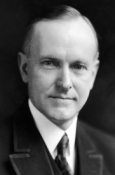
President
Calvin Coolidge
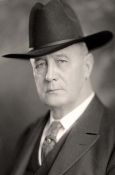
Postmaster General
Harry S. New
Music
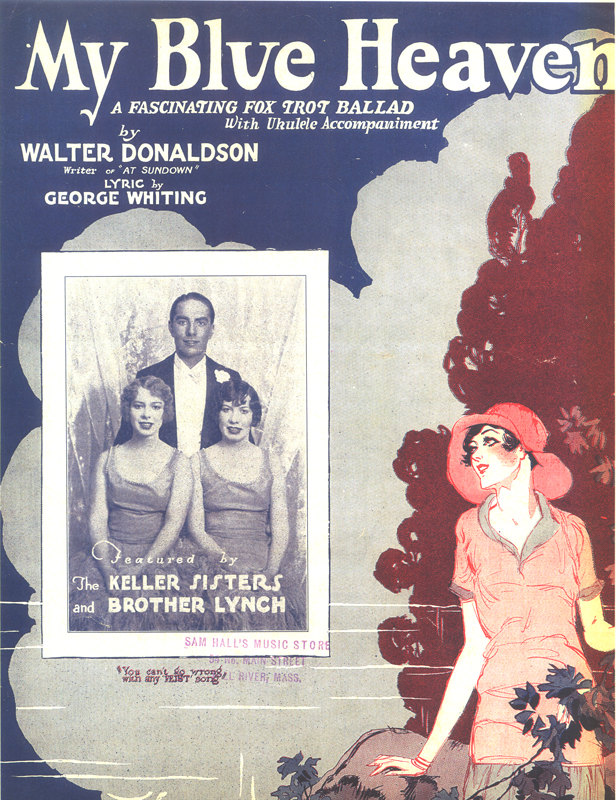
Click Control Above To Hear
1928 "My Blue Heaven
Postage Rates
Domestic Letter Rate: 2¢ per oz.
Postal Card Rate: 1¢
Postcard Rate: Jan. 1 - June 30: 2¢
Postcard Rate: June 30-Dec. 31: 1¢
Air Mail Rates
Jan. 1-Jul. 31: 10¢ - 25¢ depending on CAM
Aug. 1 - Dec. 31: 5¢ - new rate
1st Class Special Delivery
Jan. 1-June: 10¢
Aug. 1-Dec. 31: up to 2 lbs: 10¢
2-10 lbs: 20¢ over 10 lbs: 25¢
Special Handling Fee for Perishables
Jan. 1 - June 30: 25¢
Special Handling Fee for Perishables
July1 - Dec. 31: up to 2 lbs: 10¢
2-10 lbs: 15¢ over 10 lbs: 20¢
Stamps
The Commemoratives Issued in 1928
Flat Plate - Perforated 11

Washington at Valley Forge
First Day: 5/26/28
101,330,328 issued

2¢ Civil Aeronautics
First Day: 12/12/28
51,342,273 issued

5¢ Civil Aeronautics
First Day: 12/12/28
10,319,700 issued
Washington at Valley Forge
400 Subject Plates
When the fiscal budget for 1927, (July 1, 1927 through June 30, 1928), was reduced from the $8 million of the 1926 fiscal year to $7.5 million, the Postmaster was forced to tighten the belts of the stamp production process considerably. Chief among these was elimination of any new commemorative issues. It was an unfortunate coincidence that this period marked the 150th anniversary of some of the more famous events in the American Revolution, events that by all rights deserved to be commemorated by postage stamps. After much prodding, including from the then President Coolidge, Postmaster New authorized the production of the "Surrender of Burgoyne" and "Green Mountain Boys of Vermont" commemoratives in 1927. Further pressure was exerted to issue a stamp honoring the events at Valley Forge.
We find it something of a puzzle as to why it was not realized that money could be generated from the sale of commemorative stamps, especially when the date of issue coincided with a Philatelic event, as had the White Plains issue. Surely the 100,000 plus White Plains sheets sold would have covered the extra cost of producing the stamps and then some. Perhaps the revenue generated from this went into the general fund and, at least in the Postmaster's eyes, did not offset the added costs of production. (If any reader has more to add on this subject we would be glad to add it here.)
In any event, a Valley Forge stamp was authorized featuring Washington kneeling under a large tree, praying for help for his troops. First Day sales were at the Philatelic Agency in Washington, D.C. and in Lancaster, Norristown, Philadelphia, West Chester and, of course, Valley Forge, Pennsylvania. First Day sales were timed to coincide with the Midwest Philatelic Exhibition in Cleveland, where the stamp was also sold First Day. It is again something of a puzzle as to why exhibition sheets similar to the sheets issued at White Plains were not sold at the Cleveland Exhibition. Perhaps it was due to the fact that the White Plains sheets were languishing on stamp dealer's shelves. The situation was so bad that many dealers were breaking apart the sheets to sell blocks and singles to collectors who did not wish to purchase an entire sheet! This may seem incredible today, but one must remember that today's scarcity of the White Plains sheets is partially due to the fact that many were broken apart due to this lack of demand.
The International Civil Aeronautics Exhibition
200 Subject Plates
It may seem strange that with the reluctant attitude regarding new issues commemorating the 150th anniversary of the American Revolution, the Post Office so readily issued three new stamps with air mail themes in 1928 (in addition to the two stamps illustrated above, see the Beacon Air Mail stamp below). It may have been due to the persistence of the second assistant postmaster general, Irving Glover, the head of the air mail division, who rightly regarded air mail and air travel as the brave new frontier.
As with the Valley Forge stamp, the "Civil Aeronautics" issue was timed to coincide with an Exhibition, in this case non-philatelic, the International Civil Aeronautics Exhibition, in Washington, D.C. These stamps did not commemorate anything, they were strictly promotional devices, although valid for postage nonetheless. The airplane motif of the stamps confused some postal workers. Thinking that the stamps signified air mail, postage due was occasionally charged to recipients, since the air mail rate was higher than the normal rate. In reality, the stamps were for general postage and not for air mail at all.
First Day sales were at the Philatelic Agency, the main post office and at the International Civil Aeronautics Exhibition, all in Washington, D.C.
The Hawaii and Molly Pitcher Overprints of 1928
Rotary Press - Perf 11 x 10½ - 400 Subject Plates

2¢ Hawaii Overprint
5,519,897 issued
First Day: August 13, 1928

5¢ Hawaii Overprint
1,459,897 issued
First Day: August 13, 1928

2¢ Battle of Monmouth
9,779,896 issued
First Day: Oct. 20, 1928
The Hawaii Overprints of 1928
As mentioned above, the fiscal restraints placed on the Postmaster created a reluctant atmosphere for the introduction of new commemoratives. After much petitioning it was finally decided that a "surcharged" overprint would be acceptable to commemorate the 150th anniversary of the discovery of Hawaii by Captain Cook, although the surcharge was not a surcharge in the traditional sense nor did the overprint mention Captain Cook. As with the Civil Aeronautics stamps above, there was some confusion regarding the usage of this stamp, since Hawaii was a territory of the U.S. at the time, similar to Guam and Puerto Rico, among others. Many Post Offices refused to accept the overprinted stamps as valid postage, assuming the stamp was only valid in the territory of Hawaii and at least one considered the overprint as a form of cancellation. The misplacement in the Number Catalog in 1929 is a direct result of this confusion, Number considered these stamps territorial issues and at first listed them as Hawaiian stamps.
First Day sales were at the Philatelic Agency in Washington, D.C. and in Honolulu, Hawaii for both the 2¢ stamp and the 5¢ stamp. The overprint is sometimes faked, especially on the 5¢ stamp. Make sure the unused stamp has the Type II gum breakers and that the 2¢ stamp is the dull dark red, not a bright red and the 5¢ stamp a dull dark blue, not a bright or light blue.
The Molly Pitcher Overprint of 1928
The "Molly Pitcher" stamp, commemorating the Battle of Monmouth, was also the result of much lobbying for a stamp honoring New Jersey's contribution to the War of Independence. As the story goes, Mary (Molly) Hays, the wife of an artillery infantryman, delivered water to the wounded at the Battle of Monmouth, often to cries of "the pitcher, Molly". The story continues, when her husband was wounded, she took the helm at his cannon and continued until the end of the battle, making her one of the heroines of the War. Historians have questioned the authenticity of this account, but the stamp was issued by overprinting the regularly issued 2¢ stamp, much as had been done with the Hawaii overprints.
First Day sales were on October 20, 1928, (although the battle was fought on June 28), at the Philatelic Agency in Washington, D.C. and at Freehold and Red Bank, New Jersey.
The Air Mail Stamp of 1928
Flat Plate Perf 11 - 100 Subject Plates

The 5¢ Beacon Air Mail Stamp
More than 106 million issued
First Day: July 25, 1928
The 5¢ Beacon Air Mail stamp
The 5¢ rate mentioned above went into effect August 1, 1928. The purpose of the rate decrease was to increase the volume of mail, thereby increasing the revenue of the private air mail carriers, keeping them in business. The 5¢ Beacon Air Mail stamp was issued to meet this new rate.
The beacon design symbolized the new lighted airways that had been put up across the country, reflecting an awareness of safety, vital if the new air mail service was to keep public support. This stamp was, in effect, advertising for the new air mail service and rates. Extra features that were not found on other stamps such as a bi-colored design and an unusual size led to a wealth of plate and imprint varieties for philatelists. First Day sales were at the Philatelic Agency in Washington, D.C., but the number of First Day covers from that day are exceedingly scarce. This was perhaps because First Day covers issued on July 26 required two 5¢ stamps to cover the existing 10¢ rate, whereas if the collector were willing to wait a week, the August 1 rate would be 5¢ and only one stamp would be necessary. Covers from August 1, the first day of the new rate, are relatively common.
The Lindbergh Air Mail Booklet
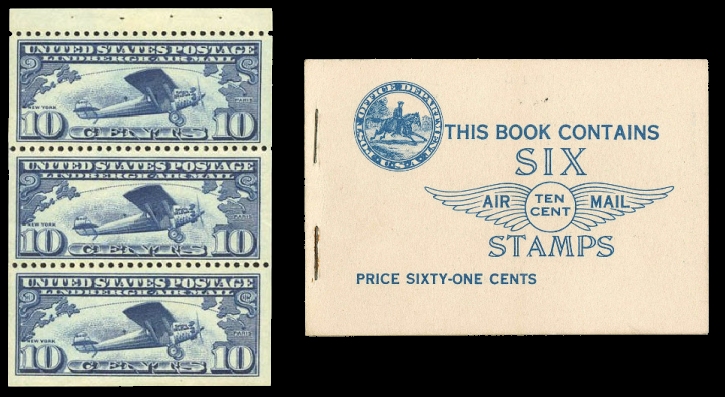
The Lindbergh Air Mail stamp was the first Air Mail stamp issued in booklet form. The booklet, Number C10a, consisted of two panes of 3 stamps each, for a total of 6 stamps and sold for one cent more than the value of the stamps it contained, that is 61¢. The small number of booklets issued, about 145,000, reflects the fact that the 10¢ stamps the booklets contained were not much in demand, since the reduced 5¢ rate for a one ounce letter sent via air mail went into effect only two months after the booklets were issued. At the time most collectors were satisfied with the ordinary stamp. Today, the booklet pane brings a good premium over three normal stamps. First Day Sales, on May 26, 1928, were at the Philatelic Agency in Washington, D.C. and at the Midwest Philatelic Exhibition in Cleveland.
The New Special Handling Postage Stamps of 1928
Flat Plate - Wet Printing - Perforated 11
200 Subject Plates - First Day: June 25, 1928
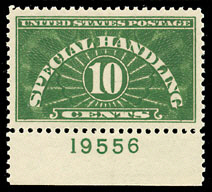
10¢ Special Handling
Wet Printing
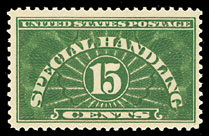
15¢ Special Handling
Wet Printing
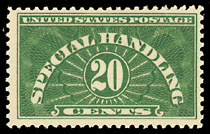
20¢ Special Handling
Wet Printing
In 1925, a special handling fee of 25¢ was added to the parcel post fee to defray some of the added expense in handling certain packages, primarily packages containing perishables such as baby livestock. This fee was not optional, but it did elevate the parcel to the status of First-Class mail, affording it the same expeditious handling and delivery. However, this fee did not provide special delivery service, the normal fees applied and a Special Delivery stamp was needed to insure special delivery service.
In mid-1928, the single 25¢ rate on all parcels required to pay the special handling fee was eliminated and replaced with a new rate structure based on the weight of the parcel: 10¢ for under two pounds, 15¢ for two to ten pounds and 20¢ for over ten pounds. Hence the three stamps above. In addition, after July 1, 1928, the special handling fee was no longer required if the special delivery service was paid for. A special handling fee is still required on certain items today.
The 25¢ yellow green stamp, printed to replenish Post Office inventories, was at press for only six days, from January 14 to January 19, 1928. The 25¢ single rate for all parcels remained in effect until July 1 of 1928, at which time the 25¢ stamp became moot, since the 20¢ stamp would cover all packages over ten pounds. In fact, most 25¢ Special Handling stamps were withdrawn from sale and redeemable as of July 9, 1928, an unprecedented move by the Post Office Department. This was in part due to the fact that unlike other postage stamps, the Special Handling stamps were never authorized to pay postage for any other purpose than to pay the required special handling fee. While the unused yellow green 25¢ stamp is common, very few postally used examples were saved and, in fact, the yellow green stamp is unknown on cover.
The Special Handling stamps were printed using the "wet" method through most of 1955, when some were printed using the new "dry" method. It should be noted that all of the Special Handling stamps were printed on flat plate presses and that the 25¢ stamp was never printed using the dry method. See also: Wet vs. Dry
The traditional method of sorting the "wet" and "dry" stamps has been to classify as dry-prints those with sharper, crisper printing and a slightly darker green color than the 1928 yellow green. Mr. Bob Rufe, in a series of articles in the 2007 United States Specialist, presents a convincing argument that this is misleading at best, since many of the stamps printed between 1940 and 1955 have just these supposed "dry" printing characteristics. In fact, he clearly illustrates an example of a wet printing from the 1940-1955 period that is indistinguishable from a dry printing in terms of color and sharpness. This "wet" stamp would end up in most dealer's "dry" stock pile. However, these stamps have over-riding characteristics showing they must be wet-prints. These characteristics are
1. The wet-print, depending on the direction of the grain of the paper, is narrower or shorter than the dry-print, typically from .4 to .7 mm. This can easily be seen by overlapping the stamp in question with a known wet-print stamp, for example any 25¢ Special Handling stamp since they were all wet-printings. If the stamp in question measures similar in both the vertical and horizontal directions, it must be a wet-print. If the stamp is noticeably longer or wider, then it might be a dry-print.
2. The dry-prints were printed on thicker, stiffer paper. Although it would require an accurate micrometer to make such measurements, many collectors can tell the difference simply by "flicking" the stamp, testing for stiffness.
This new research presents some interesting findings. Since many of the stamps that have been traditionally classified as dry-prints are actually wet-prints, the Special Handling dry-prints appear to be substantially rarer than previously thought. The dry printings are unknown properly used on a contemporary cover.
A special thank you goes to Bob Rufe for his excellent research on the subject, published in a series of articles in the United States Specialist (see http:/usstamps.org ), from Oct.-Dec. 2007, along with an update in the Oct. 2008 issue. This is must reading if you want to distinguish the wet and dry printings of these stamps.
First Day sales were at the Philatelic Agency in Washington, D.C.
See also: Wet vs. Dry
The following postage stamp varieties were first issued by the U.S. in 1928
No new varieties of U.S. Special Delivery stamps were issued in 1928
No new varieties of U.S. Postage Due stamps were issued in 1928
Regular issue
Number 634A - 2¢ Type II Washington rotary perf 11 x 10½ - EKU 12/19/1928
(note that this stamp was actually released before the coil stamp 599a)
Commemoratives
Number 645 - 2¢ Valley Forge
Designer: C. A. Huston - Engravers: E. M. Hall (frame & lettering) - L. S. Schofield (vignette& ribbons)
Number 646 - 2¢ Molly Pitcher Overprint
Number 647 - 2¢ Hawaii Overprint
Number 648 - 5¢ Hawaii Overprint
Number 649 - 2¢ International Civil Aeronautics Convention
Designers: Claire Aubrey Huston and Alvin R. Meissner - Engravers: Joachim C. Benzing (Airplane) - Louis S. Schofield (Capitol and monument) and Edward M. Hall (frame and lettering)
Number 650 - 5¢ International Civil Aeronautics Convention
Designers: Huston & Meissner - Engravers: Schofield (vignette) - Hall (frame & lettering)
Air Mail
Number C10a - The 10¢ Lindbergh Air Mail Booklet (pane)
Number C11 - 5¢ Beacon Air Mail stamp
Designer: A. R. Meissner - Engravers: Schofield (vignette) - C. F. Wittenauer (frame) - Hall (lettering)
Special Handling
Number QE1 - 10¢ Special Handling Wet Printing
Designer: C. A. Huston - Engravers: E. M. Hall (frame & lettering) - F. Lamasure (numerals)
Number QE2 - 15¢ Special Handling Wet Printing
Designer: C. A. Huston - Engravers: E. M. Hall (frame & lettering) - F. Lamasure (numerals)
Number QE3 - 20¢ Special Handling Wet Printing
Designer: C. A. Huston - Engravers: E. M. Hall (frame & lettering) - F. Lamasure (numerals)
Number QE4a - 25¢ Yellow Green Special Handling Wet Printing (see 1925 for the 25¢ dark green Special Handling stamp)





